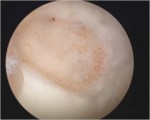Cartilage is the smooth lining on the surface of the bone that plays a role in joint lubrication and shock absorption. As we get older, the water content in cartilage decreases and other changes in it makes it vulnerable to injury. It can get worn out from traumatic sports injuries or a gradual “wear and tear” from years of impact loading of the joint.
Normal Cartilage

Articular cartilage can be damaged by injury or normal wear and tear. Cartilage is a specialized structure that has no blood or nerve supply. Once damaged, it does not regenerate itself. Current cartilage repair techniques, under certain ideal circumstances, can restore cartilage to near normal. Restoring articular cartilage can relieve pain and allow better function. Most importantly, it can delay or prevent the onset of arthritis (which is the widespread destruction of cartilage)
Large Cartilage Defect In The Knee

Surgical techniques to repair damaged cartilage are still evolving.
It is hoped that as more is learned about cartilage and the healing response, surgeons will be better able to restore an injured joint.
Cartilage Damage
Hyaline Cartilage
The main component of the joint surface is a special tissue called hyaline cartilage. When it is damaged, the joint surface may no longer be smooth. Moving bones along a tough, damaged joint surface are difficult and cause pain. Damaged cartilage can also lead to arthritis in the joint. The goal of cartilage restoration procedures is to stimulate new hyaline cartilage growth.
Identifying Cartilage Damage
In many cases, patients who have joint injuries, such as meniscal or ligament tears, will also have cartilage damage. This damage may be hard to diagnose because hyaline cartilage does not contain calcium and cannot be seen on an X-ray. An MRI scan with cartilage sequencing will be able to localise and quantify the degree of cartilage damage. If other injuries exist with cartilage damage, doctors will address all problems during cartilage regeneration surgery.
Symptoms
The symptoms of cartilage injury can co-exist with the symptoms of associated injuries such as meniscal or ligament tears. The most common symptoms are:
- Knee Pain
- Stiffness and swelling
- Catching or locking of your knee (if there is a loose cartilage piece in the knee joint)
- Limited range of motion
- Problems squatting or climbing stairs
Looking For A Reliable Knee Orthopaedic Specialist?
Fast Medical Attention, Transparent Fees
Make an appointment for comprehensive care for your knee problems!
